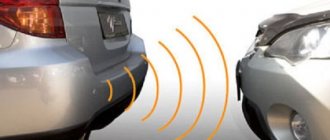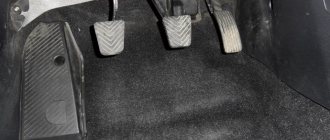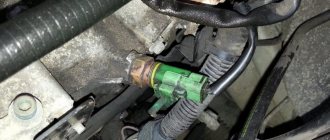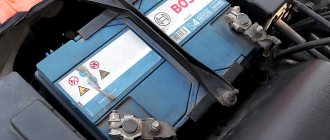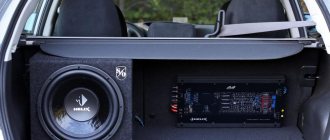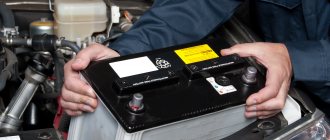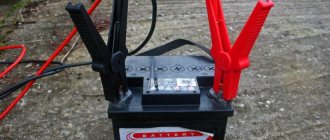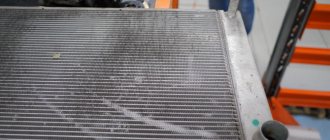What is parking radar
Parking radar is an active driver assistance system when parking. The main role in it is played by ultrasonic sensors. Parking sensors appeared in the early 90s and were initially installed on premium cars.
Parking radar
In an urban environment, such a system greatly helps drivers. You may simply not see a trash can, a high curb, or an abandoned cart when parking. Parktronic sees these obstacles and promptly warns the driver about them.
The parking radar system may include:
- sensors;
- control unit (receives and analyzes the signal);
- speaker (beeps a beep);
- display or indicator (installed in the cabin and shows the distance to the obstacle).
Parking aid components
Parking sensor device
Any parking system consists of several components:
- Ultrasonic sensors;
- Control unit;
- Data output systems (this can be a display or small speakers built into the control unit).
The number of sensors can vary depending on the model from two (as, for example, ParkAWay E-2B-ZV) to eight or more (ParkAWay E-8W-ZV).
The more there are, the better. The fact is that when only two elements are working, “dead zones” inevitably arise between them and the device may not respond to a pole or tree. Some models with two sensors allow you to connect additional ones. For example, the ParkAWay E-2W-SH radar comes with two sensitive elements, but the device supports connecting four. You can purchase additional ones in our store. A little about the design of the parking sensor. It can be mortise or surface-mounted, with a wired or wireless connection method. A wireless connection allows you to avoid running wires across the entire cabin, however, such devices are much more expensive.
Models with a display included, like the ParkAWay E-6W-D, are much more convenient to use. The screen allows you to closely monitor the approach of an obstacle.
How does parking sensor work?
The sensors are usually installed on the rear bumper. But now, more and more often, they can be found in the hallway. Ultrasonic sensors detect obstacles within a radius of 0.2 to 2 meters. If there is any obstacle, a sound signal is sounded or data is displayed on the display inside the car.
Parking sensor work
The operation of ultrasonic sensors can be compared to an echo sounder. The applied signal is reflected from the obstacle and returned back. The system analyzes the wavelength and determines the distance to the object. All this happens very quickly.
Depending on the configuration, the system can notify the driver in different ways.
The simplest way is to send a pulsating signal. The closer the obstacle, the more intense and louder the signal will be. At maximum approach it becomes continuous.
Car parking system display
More advanced models use a visual indicator or display in the cabin. The distance is displayed as divisions, numbers or an image on the screen.
In the most expensive versions, parking sensors work together with a rear view camera. The screen displays an image of the car, its trajectory, speed and objects around.
Operating principle of parking sensors
Previously, drivers were skeptical about installing this device and doubted its effectiveness.
Time passed, and the level of confidence in the device increased significantly, especially against the backdrop of an increase in the efficiency of its operation. An increasing number of modern cars are equipped with parking sensors off the assembly line. The operating principle of the parking sensors is simple and straightforward. Even a schoolboy can figure this out. The main element of the system is the ultrasonic sensor. The efficiency and reliability of the entire system depends on their quantity.
The operating principle of the electronic system is as follows:
- During operation, the sensor located on the rear bumper of the car continuously emits an ultrasonic signal. If the sent signal encounters an obstacle in the path of the vehicle, it is returned. The time required for the sent ultrasonic wave to be reflected indicates the distance to the obstacle.
- On average, the sensor is capable of detecting obstacles up to 2 meters from the car. If the obstacle is located at a distance of more than 2 meters, it can be seen in the rearview mirrors.
- The parking sensors begin to work after the driver engages reverse gear. Recently, parking sensors operating in non-automatic mode have become increasingly popular. They are convenient when driving in a large populated area with heavy traffic. Automatic electronic devices in this case constantly emit a warning signal, which is very annoying for the driver.
Parking sensor device
The parking device uses sound and light elements to warn the driver. This is very convenient, since the driver can quickly navigate and make a decision.
Number of sensors
Systems may differ in the number of sensors and their location. The more there are, the more correct and accurate the information will be. In parking sensor systems there can be from 2 to 8 pieces.
In the most budget options, only two sensors are installed. The cost of this configuration is significantly lower. But two sensors cannot cover the entire space and see some low or thin objects. They have their own “dead zone”.
The most common option is a system with four sensors on the rear bumper of the car. This quantity is optimal in terms of cost and quality of detection. The system will not respond to cars approaching from behind. Rear parking sensors are activated when you stop and engage reverse gear.
In systems with six sensors, four are placed at the rear and two at the front. Front sensors also help detect foreign objects.
Eight sensors have the most expensive and advanced models. They scan the area on both sides of the car. In order not to bother the driver with constant squeaking, the system turns on only after pressing the brake. This is how the radar understands that there will now be a maneuver back. After 20 seconds the system turns off on its own. Front parking sensors usually work independently of the rear ones and are controlled by a speed sensor. At speeds below 20 km/h, the front parking sensors are disabled.
Sensors and their number
The accuracy of the data largely depends on the number of embedded parking radar sensors. In automotive stores you can find systems with a wide variety of quantities.
The most common is four sensors that are installed in the rear bumper and two in the front. This option is optimal for a big city, where there are constant traffic jams and cars are often literally parked bumper to bumper.
In the most advanced models of parking sensors with this arrangement, it is possible to disable the front or rear sensors.
The very first radars with two sensors appeared. They can still be purchased today, but we would not recommend them because they will create dead zones, which means that thin objects, such as parking bollards, will not be detected by the radar.
Three or four sensors that are installed in the rear bumper are a good and inexpensive option. Blind spots are eliminated and you can safely park even on the narrowest street crowded with cars.
The most expensive are parking sensors with eight sensors - four on each bumper. With such a system, you will be protected from accidental collisions with any kind of obstacles. Although the design features of some car models do not allow installing such a number of sensors on the bumper.
When installing sensors, two mounting methods are used:
- mortise sensors - you have to make holes in the bumper to install them;
- invoices - they are simply glued to the bumper, although some drivers are suspicious of them and fear that they may get lost during washing.
Similar How to set up a DVR yourself
Types of parking sensors
Ultrasonic
The most common parking radar system, the operating principle of which was described above. It works by scanning space with ultrasonic waves.
Electromagnetic parking sensors (tape)
This type of parking sensors creates an electromagnetic field that also acts as a radar. It is a metallized tape. It attaches to the back of the bumper or trunk. Nothing is visible from the outside. No need to drill holes in the bumper. Ribbon parking sensors can detect an object at a distance of 5 cm, and ultrasonic parking sensors - from 20 cm. Dirt also does not interfere with it.
Ultrasonic and electromagnetic parking sensors
But electromagnetic radar can be affected by other sources of electromagnetic radiation. In the city this can happen quite often. It is also impossible to reduce or increase the sensitivity of such a radar. Ultrasonic sensors can determine the size and location of an obstacle, but electromagnetic sensors cannot do this, since there is only one.
Wireless parking sensors
Wireless sensors send a radio signal to the control unit. This is a more modern system that is becoming increasingly popular. The technology is convenient because there is no need to lay wires from each sensor.
How to use parking sensors?
Usually the parking sensors turn on when the engine starts running. The system performs a self-diagnosis and successfully enters sleep mode or shuts down completely.
The rear sensors are activated as soon as you shift into reverse. Signals begin to be sent after detecting an obstacle at a distance of 2.5 to 1.5 meters - depending on the model and its characteristics. The time between signal emission and reception is 0.08 seconds.
The front sensors are activated when the brake is applied. Drivers often turn them off because in traffic jams they will constantly notify you when you are approaching other cars.
Similar LDWS in a DVR - what is it and what is it for?
When using parking sensors, you should not rely on them completely. As practice shows, the presence of a parking radar dulls vigilance.
But they may be wrong:
- during heavy rain and snowfall;
- if moisture gets inside the sensors;
- when they are heavily contaminated.
In addition, parking sensors are powerless in front of sewer hatches, holes, and inclined surfaces (signals from them will be reflected in a completely different direction).
A cheap model may not notice a cat, dog, or child. Therefore, use parking sensors only as an aid and do not lose your vigilance. Remember that no device can protect you one hundred percent from potential danger.
Installation methods
The most effective and correct installation method is to install the system directly into the car bumper. Simply drill the holes and secure the components. It is recommended to leave the distance between the holes 30-40 centimeters. All that remains is to secure them, conduct the wiring and connect them to the control unit and indicator. The sensors themselves are small in size with a diameter of slightly more than 1 cm. They have a cylindrical shape of black or metallic color.
There are options that stick to the surface of the bumper. Not the most popular method, since from the outside it does not look very aesthetically pleasing. Also, when washed or shaken, they may simply come off. The advantage of this method is its low cost and availability.
Which parking sensor is better to choose?
Four sensors in the rear bumper of a car
When choosing parking sensors, you first need to focus on the number of sensors. Models currently available for:
- Two or three sensors. Parking radars with 2 or 3 sensors are generally considered to be outdated and uninformative. To cover all possible blind spots, there must be at least four parking sensors in the rear.
- Four sensors. All of them are installed on the rear bumper. And this amount is sufficient to “see” everything that is happening behind the car. Parking sensors with 4 sensors are very popular due to their low price, but do not provide information about obstacles ahead.
- Six sensors. Most drivers consider parking sensors consisting of six sensors (the so-called “all-round” parking sensors) to be optimal in terms of the combination of price and information content. Four are installed on the rear bumper, approximately 40 cm apart. Two more are mounted in the front bumper. This installation scheme for parking sensors has good information content and reliability. Modern models have the option of turning off sensors in the front or rear. If desired, the driver activates sensors only on the front or rear of the vehicle.
- Eight sensors . These are expensive models of parking sensors. But many novice drivers choose them, since parking radars with eight sensors detect any obstacles. The use of parking sensors with a large number of sensors has some peculiarities. Often, when driving, an overly sensitive radar distracts the driver. Therefore, devices with eight or ten sensors turn on for approximately 20 seconds at the beginning of movement. Then they are activated only when braking. Some models can be turned off by the driver using a button.
Features of operation
The parking radar can be used at any time of the year at temperatures from -35 to +80 degrees Celsius. Below -35, malfunctions may begin and the system may fail.
Parking sensors may not work correctly under the following conditions:
- Dirt, snow, ice or moisture has adhered to the sensor, which distorts the signal;
- uneven road or strong shaking;
- it is raining or snowing heavily;
- When parking in a confined space, the sensors may not work properly and an echo effect may occur.
You should also remember that the system may simply not notice some objects. This applies to thin objects such as cable, wire, chain, large grating, etc. Also, the sensors do not see holes, irregularities, sewer hatches and the like.
It happens that some sensor has failed, but the rest are working. This creates a dead viewing zone. You can check the functionality of the sensors at a service center or with a multimeter yourself.
Device
A parking radar kit usually includes:
- set of sensors (2-8 pcs.);
- display unit (graphic monitor, full display, buzzer, etc.);
- and a control center (the electronic brain of the system).
The sensors are mounted on the car body, the display unit is placed in the cabin, in front of the driver’s eyes, and the control center is the hardware part of the gadget (usually placed inside the display unit).
The parking sensors work automatically, the rear sensors turn on when you start reversing, the front sensors turn on when the vehicle speed drops to 20 km/h or less.
Next, let's look at the operating principle of the device from a physics point of view.
Installation procedure
Installation
First, a strip of masking tape is glued to the bumpers at the intended location of the sensors. The location for placing the sensors is selected in such a way that there is enough free space behind it.
Removing the bumper is usually not required. There is a line on the bumper from which you can make markings - for example, a long and even bend, some kind of overlay, and so on. From this place, 4 points are marked at equal heights and with equal distances between each other on each bumper.
It is important, having clearly marked the holes, move away a certain distance and visually assess their location - how smoothly the markings are made. If everything is in order, holes are drilled using a screwdriver and the crown that comes with the parking sensors. Next, the masking tape is removed, and the burrs are removed with a sharp knife.
On the video how to install rear and front parking sensors:
Electronics placement
- Now you need to decide on the location of the central parking sensor unit. Typically it is located at the rear of the vehicle as it requires connection to the reverse signal. Since many cars have a reversing light, the block must be placed on its side.
- The parking sensor display is mounted either on the dashboard or, which is often more convenient, on the rearview mirror. Most often, fastening is carried out using double-sided tape. Before gluing, both surfaces are thoroughly degreased.
- The wire from the display runs under the A-pillar up and then under the door seals and the B-pillar to the rear of the car to the main parking sensors unit.
- The central unit itself is connected to the vehicle ground, the reverse signal (for the operation of sensors in the rear bumper) and the positive after the ignition switch (for the operation of the front sensors). In the rear of the car, it is easiest to find the ignition plus powered by the fuel pump; in this case, the parking sensors will only work when the engine is running - this is often convenient.
You may also be interested in learning about which car alarm is best to use in your car.
But you can learn from the article how to properly install a car alarm with auto start with your own hands.
You can run the power wire from the fuse box along with the wire from the display, and also connect to the rear dimensions. All the necessary wires can be easily found with a simple LED probe.
- The sensors themselves are installed using a hook made of thick copper wire. First, the sensor is installed on the side opposite to the placement of the parking sensors unit.
- First, the hook from the next hole in order is drawn into the desired one, then it clings to the wire and pulls it through.
- Two wires are pulled from the second hole to the third, and so on. Having passed all four wires, they are straightened and bundled with electrical tape, and then passed inside the car through a suitable plug.
It is important not to confuse their order (for example, 1-2-3-4 from left to right, or L-LC-RC-R). Do not press hard on the middle of the sensor when snapping it into the bumper, as this may damage it.
- Then the wires from the sensors are fixed in possible places with nylon ties and connected to the central unit.
As you can see, contacting a specialist to install a parking radar is not at all necessary if you are confident in your abilities.
However, for a better result, you can also install front parking sensors with a camera; you can learn more about the procedure itself from the article by following the link.
But which parking sensors with a camera are the best and how to choose the right one, the information from the article will help you figure it out.
It will also be interesting to look and find out what parking sensor prices exist. All information is detailed in the article.
Which is better parking sensors or rear view camera
If you choose between parking sensors and a rear view camera, then it is better to choose the camera as a more informative system. The driver will have 100% visibility of the space behind the car, which will allow him not to miss even the smallest obstacles.
Please note that the rear view camera has a number of significant disadvantages:
- This is an expensive solution that will also require the purchase of a color screen for image display;
- Cheap camera models are not effective at night;
- The camera does not have a sound warning system for approaching obstacles.
Parking sensors for 8 sensors
The ideal solution in all respects for achieving the best safety when driving in a cramped yard or a parking lot crowded with other cars is to install parking sensors with 8 sensors that provide circular scanning* in order to detect potentially dangerous obstacles that threaten to cause various damage to a car moving nearby. Timely warning of the driver about the danger of a collision will help:
- reduce vehicle maintenance costs;
- reduce the amount of payments under compulsory motor liability insurance by reducing the accident rate;
- reduce costs for minor repairs;
- save time on assessing damage and recording accidents.
* Parking sensors are mounted in the front and rear bumpers to scan the space in front and behind the vehicle at a distance specified by the equipment. Scanning distances vary due to the use of ultrasound equipment with different sensitivity levels.
Installing parking sensors with 8 sensors on a car is beneficial, since parking equipment that helps with parking:
- warns about a threat along the route;
- does not require maintenance**;
- Provides crash protection for little money.
** Parking sensors built into the bumper require periodic cleaning, which guarantees the operation of the parking sensors for a long time without the need for major or minor repairs.
CarWorks auto repair shops will be able to very profitably and at a low price in Moscow install parking sensors with 8 sensors on cars of any make and model. The range of ready-to-install kits includes solutions from different manufacturers in various configurations.
Prices for parking sensors for 8 sensors with installation
| Parking radar | Cost with installation |
| Parking radar Parkmaster 8 FJ 27 | from 14,000 rub.* |
| Parking radar Parkmaster 238 | from 16,000 rub.* |
| Parking radar Spark 8 D | from 14,000 rub.* |
* cost may vary depending on the complexity of equipment installation and the need to dismantle/install bumpers.
Fast and inexpensive installation
Installation of parking radars with 8 sensors is carried out by qualified craftsmen with 5 years of experience, which allows us to guarantee:
- high quality of execution of incoming orders;
- minimum installation time for equipment of any type and complexity;
- long-term guarantee for the work done;
- qualified consultation on the use of radar in various conditions;
- installation of a good parking sensor with 8 sensors with a camera (optional) with time-tested functionality.
You can also order parking sensors from us with installation and delivery, which allows you to purchase a kit that is not in stock at the time of your request, but is available from suppliers. The delivery time for ordered equipment before installation of the radar on the vehicle ranges from two weeks or more, depending on the selected model and configuration.
Parking sensors with 8 sensors are available for installation on a vehicle in the following versions:
- about a sound notification (the driver is notified of the appearance of an obstacle on the way by an acoustic signal of a set volume with an increasing frequency as he approaches the object that interferes with movement);
- with sound and visual notification (notification is carried out by giving a signal and LED indication on the control unit mounted on the panel);
- with a display (separate or built into the rear view mirror) with graphical visualization of information about detected obstacles with simultaneous acoustic notification;
- with complete rear camera.
8 + 2
The best option for an 8-point parking radar for installation is with a camera and a display unit, which, depending on the specific model, can display in real time:
- number of active sensors (helps check the functionality of all sensors mounted in the rear and front bumper, relevant only for some expensive kits);
- distance to the found obstacle in meters or conventional units (depending on the display method and screen features);
- alert volume;
- image from the rear view camera (only for kits with a video camera).
What are the features of using parking sensors?
Having studied enough information about the parking system and looked at the parking sensors in the photo, you have made your choice and installed the miracle device in your car. It should be remembered that technology needs human care. And in order for its operation to be trouble-free and correct, it is necessary to take into account the nuances listed below and try to prevent them. Problems in the operation of parking sensors can be created by:
- dirt, ice and snow stuck to the sensors;
- if the car is moving on an uneven road or on an incline;
- rough terrain can also cause misleading signals;
- increased noise;
- adverse weather conditions;
- radio;
- dents and holes in the asphalt;
- not closed sewer hatches;
- sharp or thin objects.
Be sure to take note of this and do not rely 100% on technology, because it cannot always ensure your safety.
The main prerogative of parking sensors is the ability to monitor areas that the driver cannot control from his seat, i.e. so-called “blind spots”. This will help avoid accidents and other difficulties for the driver on the road.
Share:

